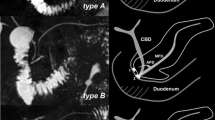Abstract
To compare the performance of MR-cholangiopancreatography (MRCP) and that of classical anatomy in the depiction of the main pancreatic duct, 50 MRCP examinations were done in patients free of pancreatic disease. Axial and coronal sections 20 mm thick were obtained in a Single Shot Fast Spin Echo (SSFSE) sequence. The following were analyzed: (1) visibility of pancreatic duct structures, (2) form of the main pancreatic duct, (3) various angulations of the duct and (4) diameter of the duct. Anatomic variants were noted. These findings were compared with anatomic and radio-anatomic (ERCP) data in the literature. The main pancreatic duct was visualized in 100% of cases and the accessory pancreatic duct in 61%. The form, diameter and angulations of the various segments of the pancreatic duct were similar to those reported in the literature. These findings are reported in the axial and coronal planes. Comparison with major anatomic classifications was not possible. MRCP enables in vivo anatomic exploration of the main pancreatic duct. Horizontal sections provided new radio-anatomic information. The technique nevertheless remains limited by poor spatial resolution. The French version of this article is available in the form of electronic supplementary material and can be obtained by using the Springer Link server located at http://dx.doi.org/10.1007/s00276-002-0082-x.
Résumé
Pour confronter la cholangio-pancréato-IRM (CPIRM) à l'anatomie classique dans l'exploration du conduit pancréatique principal, 50 CPIRM ont été réalisées sur des patients sans pathologie pancréatique. Des coupes frontales et horizontales de 20 mm d'épaisseur ont été réalisées en séquence Single Shot Fast Spin Echo (SSFSE). Ont été analysés: (1) la visibilité des structures canalaires pancréatiques; (2) la forme du conduit pancréatique principal; (3) les différentes angulations de ce conduit; et (4) le diamètre du conduit. Les variations anatomiques ont été notées. Ces données ont été confrontées aux données anatomiques et radio-anatomiques (CPRE) de la littérature. Le conduit pancréatique principal a été visualisé dans 100% des cas, le conduit pancréatique accessoire dans 61% des cas sur des coupes horizontales. La forme, le diamètre, et les angulations des différents segments du conduit pancréatique étaient proches de ceux relevés dans la littérature mais, ces dernières ayant été rapportées dans les plans frontaux, la confrontation de notre série aux grandes classifications anatomiques ne fut pas possible. La CPIRM permet l'exploration anatomique in vivo du conduit pancréatique principal. La réalisation de coupes horizontales apporte de nouvelles données radio-anatomiques. Toutefois, la technique est encore limitée par une faible résolution spatiale.







Similar content being viewed by others
References
Asselah T, Ernst O, L'herminé C, Paris JC (1998) Cholangiopancréatographie par IRM. Gastoenterol Clin Biol 22: 320–327
Aubé C, Godoy JM, Vuillemin E, Burtin P, Boyer J, Caron C (1998) Evaluation d'une nouvelle séquence de cholangiographie IRM avec acquisition en demi-plan de Fourier. J Radiol 79: 1487–1492
Berman LG, Prior JT, Abramow SM, Ziegler D (1960) A study of the pancreatic duct system in man by the use of vinyl acetate casts of postmortem preparations. Surg Gynecol Obstet 110: 391–403
Bret PM, Reinhold C, Taourel P, Guibaud L, Atri M, Barkun AN (1996) Pancreas divisum: evaluation with MR pancreatography. Radiology 199: 99–103
Classen M (1972) Anatomy of the pancreatic duct. Endoscopy 5: 14–17
Cordier G, Arsac M (1952) Le canal de Wirsung: quelques précisions sur sa topographie et les connexions bilio-pancréatiques. J Chir 68: 35–47
Darnis E, Cronier P, Mercier P, Moreau P, Pillet J, Boyer J (1984) A radio-anatomical study in vivo on pancreatic ducts. Anat Clin 6: 106–109
David V, Reinhold C, Hochman M et al. (1988) Pitfalls in the interpretation of MR cholangiopancreatography. AJR Am J Roentgenol 170: 1055–1059
Delhaye M, Engelhom L, Cremer M (1985) Pancreas divisum: congenital anatomic variant or anomaly? Gastroenterology 89: 951–958
Dowsett JF, Rode J, Russel RCG (1989) Annular pancreas: a clinical, endoscopic and immunohistochemical study. Gut 30: 130–135
Dupuy DE, Costello P, Ecker CP (1992) Spiral CT of the pancreas. Radiology 183: 815–818
Hidaka T, Hirohashi S, Uchida H, et al (1998) Annular pancreas diagnosed by single-shot MR cholangiopancreatography. Magnet Reson Imaging 16: 441–444
Kasugai T, Kuno N, Kovayashi S, Hattori K (1972) Endoscopic pancreatocholangiography. Gastroenterology 63: 217–227
Pavone P, Laghi A, Panebianco V, Catalano C, Lobina L, Passariello R (1998) MR-cholangiography: techniques and clinical applications. Eur Radiol 8: 901–910
Reinhold C, Bret P (1996) Current status of MR-cholangiography. AJR Am J Roentgenol 166: 1285–1295
Rösch T, Classen M (1992) Gastroenterologic endosonography. Thieme, Stuttgart
Smanio T (1969) Proposed nomenclature and classification. Int Surg 52: 125–133
Van Hoe L, Gryspeerdt S, Vanbeckevoort D et al. (1988) Normal vaterian sphincter complex: evaluation of morphology and contractility with dynamic single-shot MR-cholangiopancreatography. AJR Am J Roentgenol 170: 1497–1500
Warshaw AL, Simeone JF, Schapiro RH, Flavin-Warshaw B (1990) Evaluation and treatment of the dominant dorsal duct syndrome (pancreas divisum redefined). Am J Surg 159: 59–64
Author information
Authors and Affiliations
Corresponding author
Additional information
The French version of this article is available in the form of electronic supplementary material and can be obtained by using the Springer Link server located at http://dx.doi.org/10.1007/s00276-002-0082-x
Rights and permissions
About this article
Cite this article
Aubé, C., Hentati, N., Tanguy, JY. et al. Radio-anatomic study of the pancreatic duct by MR cholangiopancreatography. Surg Radiol Anat 25, 64–69 (2003). https://doi.org/10.1007/s00276-002-0082-x
Received:
Accepted:
Published:
Issue Date:
DOI: https://doi.org/10.1007/s00276-002-0082-x




